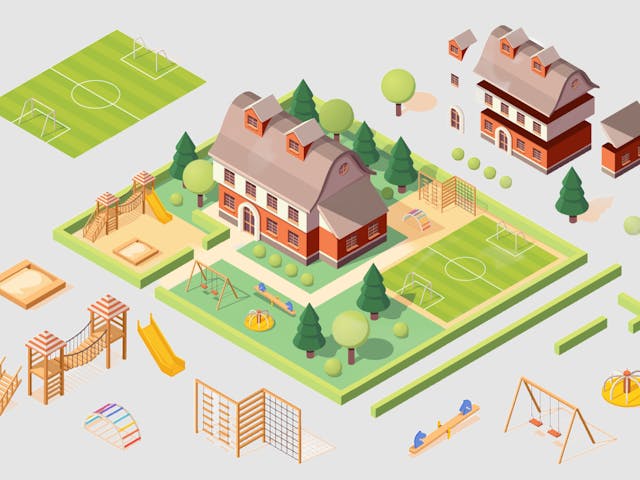HOUSTON — On a Tuesday in August, one day before the official start of the school year, the halls of Jefferson Early Learning Center were filled with the tinkling chatter of pre-K students who were escorted by their parents to meet the teachers.
But to reach those classrooms, families had to traverse the parking lot in the choking Texas heat, which rolled off the pavement in waves. That month, the temperature reached a record-breaking average high of 102.7 degrees.
Back inside, Glenn Jarrett pointed out features of the school building interior that might be easy for most people to overlook, but that stand out to him as the Alief Independent School District’s director of construction and facilities. Details like the use of earth tones throughout the school and light-colored wooden beams in the ceiling. Those beams support awning-like overhangs, which shield the temperature-treated glass windows of the cafeteria and the tiny, scaled-down furniture within from being beaten by direct sunlight.
In the hallway, Jarrett pointed at more windows strategically placed up high — too high for even the tallest grown-up to see through.
“You have all that light that's coming in naturally up above, and then you have the white walls that reflect it down,” Jarrett explained. He motioned to the lights overhead. “You don't even have to have those on to have light in the building.”
The LED lights are on, though, because it would make people nervous to walk around without them, he added.
The point of all these design choices is to reduce the impact of the scorching outside temperatures. They’re just a few of the ways Jarrett and other experts say excessive heat, along with other environmental issues brought on by climate change, are shifting the way schools are built and renovated.
Extreme heat waves recently caused some schools in the Northeast and Midwest to cancel classes, and rising temperatures are prompting some school districts in states like Utah to add air conditioning to campuses that didn’t need them in years past. More frequent and powerful natural disasters are adding tangible costs, too, pushing thousands more districts to shell out for insurance.

A Long Time Coming
Dan Boggio, founder and executive chairman of national architectural firm PBK, says his company has been designing schools with extreme heat in mind for about 10 years. But it’s typically architects who bring up the need for climate-related features rather than a conversation initiated by district personnel, he adds.
“When we start a planning process for new schools and renovations, we have an entire list of things we bring forward as a result of climate change,” Boggio says, like the adoption of solar panels to cut down energy use or double-paned glass to keep out heat.
As Boggio explains how climate change has affected his firm’s approach to building schools, he describes changes that touch nearly every aspect of the process, from selection of a building site (preferably somewhere with lots of surrounding green space) to the choice of paint colors (nothing dark that will absorb heat).
“We don’t want to be in a sea of concrete, because that increases the temperature of the microenvironment — we call it a heat sink,” Boggio explains. “We’re saving more trees than ever on these sites. It used to be we would just typically mow down all the trees to get the baseball diamonds and the football practice fields in.”
Much of what Boggio describes about new construction and renovation deals points to a singular goal: reflect as much heat as possible.
His architects are using what he calls “high-performance glass,” once reserved for high-rise buildings, on schools to cut down on solar radiation. School attics are renovated with reflective material that will keep heat from penetrating further down. Brick buildings that are 70 or 80 years old are painted with an elastomeric coating — i.e., rubbery paint — to reflect sunlight that would normally be absorbed by the masonry and create what Boggio calls a “heat battery.”
The buildings themselves and mechanical equipment are being built higher up to protect them from flooding. In Texas, for example, “it used to be that we had to have them out of the 100-year floodplain; now they have to be a certain distance higher,” Boggio says. And for equipment that sits outside, like condensers, “we're raising them up on racks because [of] the increased amount of flooding that is a direct result of climate change.”

Sites for Resiliency
Beyond their primary use for day-to-day education, schools are also likely to be used as either cooling centers or natural disaster shelters, Boggio adds, which means they need to be outfitted with bigger generators that can offer residents a reprieve from extreme heat in case of a power outage — not simply preserve thousands of dollars worth of food as was expected in years past.
Designing schools that can serve as what architects call “resiliency hubs'' could play a crucial role in protecting vulnerable communities from extreme weather, says Shivani Langer, a senior project architect and senior regenerative design adviser at the firm Perkins&Will Austin. She mentioned the deadly winter storm that knocked out power across Texas in 2021 as an example of a time when such a hub could benefit a whole town.
“Especially in this country, there is always a public school in every community, and the elementary schools are pretty close in distance to where the people live,” Langer says. “Why can't one school, at least, in each community be that place of shelter? If we do that, then we truly will serve all the communities, not just the communities that have the resources to get a true hub that can survive in a climate disaster.”
The design considerations of school-based resiliency hubs would center on keeping the people inside comfortable in the climate conditions of that particular community, Langer explains. In the case of extreme heat, that might mean having sufficient backup power to cool the building during a power outage or being able to collect condensation from the air conditioning system to run sinks and toilets during a water outage. A school cafeteria might even be designed with an exterior window counter, Langer says, where people could walk up and be served meals after a disaster.
Even as architects recommend climate-minded designs, the cost of implementing them can be a deterrent for school districts.
“It's all about survivability, which does mean power backup — which can be expensive,” Langer says. “That's why I think it needs to be something that, as a community, has to be decided.”
For example, she explains, a school district may opt to climate-proof only certain schools, rather than every single possible building. That’s not to say that schools are doing nothing if they don’t have a resiliency hub, she adds. Rather, they may be taking steps like making buildings more energy efficient or choosing landscaping that requires less water, which are better for the environment.
Ultimately, Langer says, it’s important to keep in mind that schools are designed for a vulnerable population: the children who will deal with the effects of climate change throughout their lives. She believes that better school design can be a teaching tool that encourages youth to be better stewards of the environment as they grow up.
“I know we rely a lot on the teachers to do the job for us, but as designers of education facilities, I think we have a big responsibility to also be the teachers for the users that will occupy our buildings,” she says. “These buildings are designed for 50 to 100 years. They are gonna see thousands and thousands of students. So our decisions are very important.”
Keeping the Heat at Bay
At Jefferson Early Learning Center, one of the school district’s newest buildings, adaptations to the heat and risk of flood are woven throughout the design. The large green space on the campus’ right side is planted with native grasses, a project done in partnership with the nonprofit The Nature Conservancy, and it will serve as a retention pond during heavy rains to fight off flooding, explains Jarrett, the district facilities leader.
Jarrett says there are other signs of the rising heat’s impact on schools in the district. The synthetic turf on the high school football field, which at times got as hot as 120 degrees, was replaced at the end of its lifecycle with new turf that didn’t hold onto heat. School visitors won’t find metal slides on playgrounds anymore, he points out, and wooden coverings have replaced canvas coverings as the need to shade students during outdoor activities became more permanent.
Outdoor temperatures have gotten so hot, Alief ISD Police Chief Dan Turner says, that dogs in his K-9 unit have to wear booties to protect their paws from scalding pavement.
Some of the biggest climate-related design changes have been to schools’ heating and cooling systems, says Jeff Delisle, Jarrett’s colleague at the school district and director of maintenance and operations. The systems were once built with the understanding that the highest average temperature outside would be 95 degrees, Delisle explains, but that standard has been increased to 100 degrees.
The black rubber roofs of 20 years ago are gone, he adds, replaced by white painted roofs and double the insulation.
“People that are much smarter than us have seen this coming for a long time,” Delisle says. “It’s the reason energy [standards] have been changing every six or seven years to get more and more stringent in terms of how we're going to conserve energy, how we're going to heat and cool our buildings, how we can do that in a way that's most efficient.”


